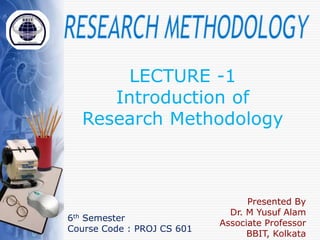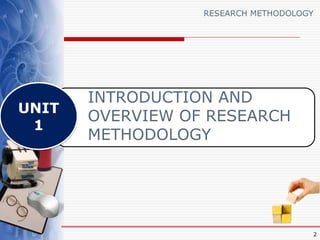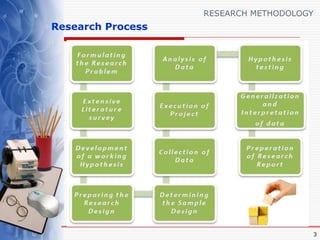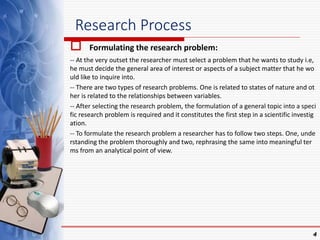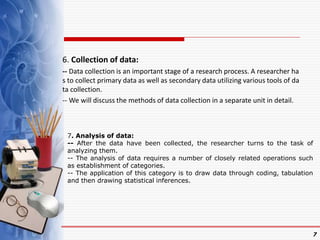Research Methodology-Introduction.ppt
- 1. Presented By Dr. M Yusuf Alam Associate Professor BBIT, Kolkata LECTURE -1 Introduction of Research Methodology 6th Semester Course Code : PROJ CS 601
- 2. 2 UNIT 1 RESEARCH METHODOLOGY INTRODUCTION AND OVERVIEW OF RESEARCH METHODOLOGY
- 4. Research Process ’ü» Formulating the research problem: -- At the very outset the researcher must select a problem that he wants to study i.e, he must decide the general area of interest or aspects of a subject matter that he wo uld like to inquire into. -- There are two types of research problems. One is related to states of nature and ot her is related to the relationships between variables. -- After selecting the research problem, the formulation of a general topic into a speci fic research problem is required and it constitutes the first step in a scientific investig ation. -- To formulate the research problem a researcher has to follow two steps. One, unde rstanding the problem thoroughly and two, rephrasing the same into meaningful ter ms from an analytical point of view. 4
- 5. 6/15/2023 5 2. Literature review: -- Once the problems is formulated a brief summary of the problem should be written down. -- In this second stage the researcher should undertake extensive literature survey connected with the problem. -- A good library will be a great help to the researcher at this stage. 3. Development of working hypothesis: -- In the second stage the researcher must collect all the necessary information regarding the research problem from the literature survey. -- After this stage, the research should state in clear terms of the working hypothesis. -- Working hypothesis is a tentative assumption made in order to draw out and test its logical or empirical consequences. -- It sharpens his thinking and focuses attention on the more important facets of the problem.
- 6. ’ü» 4. Preparing the research design: -- In this stage the researcher has to prepare a research design. It is conceptual st ructure within which the research should be conducted. -- The preparation of such a design facilitates the researcher by providing the rel evant evidence with minimal expenditure of effort, time and money. 6 5. Determining sample design: -- The research must decide the way of selecting a sample or what is popularly known as the sample design. -- It is a plan determined before any data are actually collected or before obtaining a sample from a given population. -- The researcher can adopt any type of sample design from the followingŌĆö (i) Deliberate sampling. (ii) Random sampling. (iii) Systematic sampling. (iv) Stratified sampling. (v) Quota sampling. (vi) Cluster sampling and area sampling. (vii) Multi stage sampling. (viii) Sequential sampling.
- 7. 6. Collection of data: -- Data collection is an important stage of a research process. A researcher ha s to collect primary data as well as secondary data utilizing various tools of da ta collection. -- We will discuss the methods of data collection in a separate unit in detail. 7 7. Analysis of data: -- After the data have been collected, the researcher turns to the task of analyzing them. -- The analysis of data requires a number of closely related operations such as establishment of categories. -- The application of this category is to draw data through coding, tabulation and then drawing statistical inferences.
- 8. Continued... ’ü» 8. Hypothesis testing: After analyzing the data with the help of variou s data analyzing techniques the researcher is in a position to test the hypothesis, if any, he had formulated earlier. ’ü» 9. Generalizations and interpretations: After the hypothesis testing th e researcher can come to the end and he can generalize the investigat ed findings to build theory. ’ü» 10. Preparation of the report: Finally, the researcher has to prepare th e report or the thesis on what has been done by him. In this stage, th e use of text, font, layout are some important aspects. 8
- 9. 9 NCERT is established in 1961. NCERT is an autonomous - organization, working as an academic wing of the Ministry of Education. National Institute of Education (NIE) at Delhi and 4 regional colleges of education at Ajmer, Bhopal, Bhubaneswar and Mysore. of state. The role of NCERT in Indian Education : NCERT organizes / conducts various programmes with respect to Research, Development, Training, Extension- services, publishing study - material, and evaluation. It aims at qualitative improvement of school - education. rather than quantitative expansion. To establish a National Institute of Education and manage f the development of research. National Council of Educational Research and Training(NCERT)
- 10. 10 Plays a significant and remedial role in balancing the socio-economic fabric of the Country. MHRD was created on September 26, 1985, through the 174th amendment to the Government of India MHRD works through two departments: ’é¦Department of School Education & Literacy ’é¦Department of Higher Education Objectives ’é¦Formulating the National Policy on Education and to ensure implementation. ’é¦Paying special attention to disadvantaged groups like the poor, females and the minorities ’é¦Provide financial help in the form of scholarships, loan subsidy, etc to deserving students from deprived sections of the society. ’é¦Encouraging international co-operation in the field of education Ministry of Human Resource and Development (MHRD)
- 11. 11 ’é¦Established in the year of 1969 to promote research in social sciences in the country ’é¦Review the progress of social science research ’é¦Give financial support to institutions, associations, and journals engaged in social science research ’é¦Arrange for technical training in research methodology and to provide guidance for research ’é¦Advise the Government of India on all matters pertaining to social science research as may be referred to it from time to time ’é¦Provide scholarships and fellowships for research in social sciences ’é¦Sponsor social science research programmes and projects Indian Council of Social Science Research (ICSSR)
- 12. 12 ’é¦It is an online digital library of educational research and information. ’é¦ERIC is sponsored by the Institute of Education Sciences of Department of Education, United States ’é¦The mission of ERIC is to provide a comprehensive, easy-to- use, searchable, Internet-based bibliographic and full-text database of education research and information for educators, researchers, and the general public. ’é¦ERIC provides access to more than 1.3 million bibliographic records (citations, abstracts, and other pertinent data) ’é¦ERIC provides a centralized Web site for searching the ERIC Collection Education Resources Information Centre (ERIC)
- 13. 13 It was established in May 1971, Objectives: ’é¦Formulation of policies relating to Science and Technology. ’é¦Promotion of new areas of Science and Technology ’é¦Provides basic and applied research in National Institutions. ’é¦Fostering International Cooperation in S&T. ’é¦Popularisation of Science & Technology. ’é¦Sponsoring scientific and technological surveys ’é¦Support and Grants-in-aid to Scientific Research Institutions Department of Science and Technology (DST)
- 14. Descriptive and Analytic studies ’ü» Descriptive studies generate hypotheses by answering the questions Who, What, Where, and When whereas analytic studies test these hypotheses by answering the questions Why and How. ’ü» Descriptive studies provide information on the frequency of occurrence of a particular condition and on patterns of occurrence according to such attribu tes as person, place, and time. Routinely collected statistics from such sourc es as mortality data, hospital discharge records, general health surveys, and disease surveillance programs are used for most descriptive studies. ’ü» Analytic studies measure the association between exposure and outcome a nd also include a comparison group. ’ü» The differences between these types of observational epidemiologic studies can be described below; 14
- 15. ’ü» Descriptive studies ’ü» Generates hypotheses ’ü» Answer the who, what, where and when questions ’ü» Can be a case report, case series, cross sectional or correlational studies ’ü» Tools include person, time and place dimensions of a disease ’ü» Ensures understanding of the basic dimensions of a disease ’ü» Analytic studies ’ü» Test hypothesis ’ü» Answer the why and how questions ’ü» Can be case control , cross sectional studies ’ü» Enables risk assessment of diseases among populations ’ü» Tools include measures of association (odds ratio, relative risk and correla tion coefficient) ’ü» Study incidence rates and prevalence of diseases in populations 15
- 16. Applied and Fundamental Research ’ü» A research can either be an applied research or a fundamental one. Applie d research is based on action and the main objective of this research is to fi nd a solution for an immediate problem facing the society, media industry or business organization. ’ü» On the other hand, fundamental research is mainly concerned with general ization and with the formulation of a theory. Pauline V. Young in his book ŌĆ£S cientific Social Survey and ResearchŌĆØ defines that ŌĆ£gathering knowledge for knowledgeŌĆÖs sake is termed ŌĆśpureŌĆÖ and ŌĆśbasicŌĆÖ research.ŌĆØ ’ü» As discussed above, applied research aims at certain conclusion or solution of a concrete social or business problem. On the contrary, a research study on the human behaviors and media behaviour is a fundamental research. 16
- 17. Qualitative vs Quantitative Research ’ü» These two types of researches are the most important types not only for the s ocial science research but also for some related disciplines like mass media, jo urnalism etc. These two types are also used in the research of the natural scie nces. ’ü» The main objective of the quantitative research is to develop and employ mat hematical models, theories and hypothesis pertaining to natural phenomena relating to or involving quality or kind. ’ü» Qualitative Research is an umbrella covering several forms of inquiry that he lp us understand and explain the meaning of social phenomena with as little disruption to the natural setting as possible. Qualitative research is concerned with non statistical methods of inquiry and analysis of social phenomena. It d raws on an inductive process in which themes and categories emerge through analysis of data collected by such techniques as interviews, observations, vide otapes, and case studies. Samples are usually small and are often purposively selected 17
- 18. ContinuedŌĆ” ’ü» Qualitative research uses detailed descriptions from the perspective of t he research participants themselves as a means of examining specific iss ues and problems under study. ’ü» Qualitative research differs from quantitative research in that the latter i s characterized by the use of large samples, standardized measures, a de ductive approach, and highly structured interview instruments to collect data for hypothesis testing (Marlow, 1993). In contrast to qualitative rese arch, in quantitative research easily quantifiable categories are typically generated before the study and statistical techniques are used to analyz e the data collected. 18
- 19. Conceptual and Empirical Research ’ü» C. R. Kothari defines that conceptual research is the one which is relat ed to some abstract idea (s) or theory. It is generally used by the philo sophers and thinkers to develop new concepts or to reinterpret the ex isting one. ’ü» On the contrary, empirical research relies on experience or observatio n alone, often without due regard for system and theory. It is a data-b ased research, coming up with conclusion which is capable of being v erified by observation or experiment. ’ü» We can also call it the experimental type of research. It is an appropri ate method, when proof is sought that certain variables affect other v ariables in some way. 19

